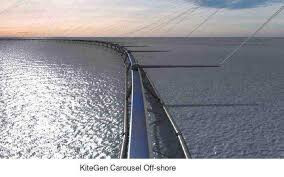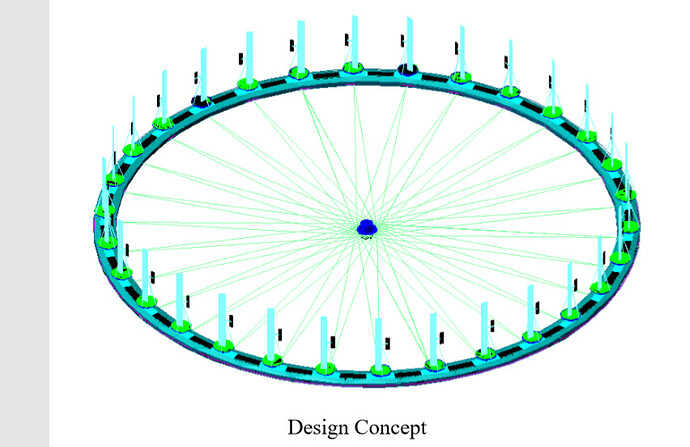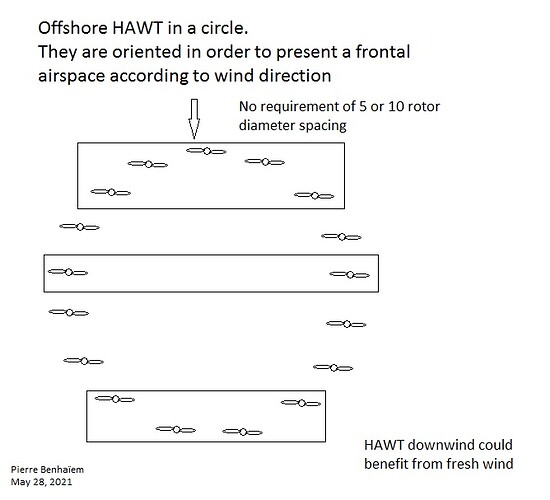Below are some information from the engineer Guy Mercer, author of the concept discussed on the current topic:
Dear Pierre Benhaiem,
You may publish these answers if you wish.
You are correct in that the giant VAWT will have a much greater power / Km^2 than any HAWT farm. But it will also be greater than a farm of traditional sized VAWTs. In part due to the vertical height which is captured but also the efficiency of the aerofoils for 2 reasons:
- With a large diameter the chord of the aerofoils can be increased which increases the Reynolds number.
This has the effect of increasing the lift to drag ratio and the absolute coefficient of lift.
That results in much greater tangential force (per unit aerofoil area) magnifying the power output.
- The large diameter reduces the speed of rotation ( for a given TSR ) which decreases the rate of change of the apparent wind to the tangent. This enables wind velocity sensitive, aerodynamic balance to be used to control the AOA ( angle of attack).
The ability of the aerofoil to automatically pitch protects the system in extreme weather conditions but from initial spread sheet calculations it also increases the power output by 11% compared to using fixed aerofoils.
Note I have not added in the 11% since I used Qblade for simulation, which does not include a pitching facility.
It may be possible to increase the power further using full servo driven pitch control, but the additional cost and maintenance requirements may not be justified.
Friction:
It is not possible to avoid friction, but it can be minimized or used to advantage:
In an offshore version it is ideal to take advantage of the friction creating a link between the turbine and the water, such that the water becomes an integral part of the system acting as a massive flywheel. I have attached a simply example of Couette flow analysis showing an example of water drag on the flywheel.
Because the amount of energy that can be stored kinetically is so large it makes it possible to store energy from strong winds while still generating at maximum capacity and use that energy to supplement the power of lighter winds potentially increasing the annual generating capacity by around 25%.
Safety in the harshest of marine environment:
My initial thought was for a continuous hull with a trapped air curtain about 1 metre thick under it fed from a small compressor operating at around 1 Bar. Such a system would displace up to 10 metres of water but have lower friction due to the air cushion.
This is valid option for an onshore version but as mentioned in the maxwindpower.com site:
For the offshore version: The ring which supports the aerofoils can be a skeletal structure, made in sections and of neutral buoyancy, mainly several metres below the water line with ” conning towers / floats ” above water and on which the aerofoils are mounted to ensure they are well clear of any storm / freak waves. This achieves 3 things: (1) Boat access to the generating hub. (2) Very little stress on the support structure due to waves as most is below the water. (3) The support structure and the links to the hub create a friction link to the water. The structure and the water become a giant flywheel of millions of tonnes storing multi GWh of energy. As with any battery / flywheel there are losses but Couette flow analysis indicates that this is relatively minimal.
In that manner it is quite easy to ensure that the bottom of any aerofoil is at least 40 metres above the nominal sea level.
Kind Regards
Guy Mercer
Water drag on floating flywheel of a giant VAWT .
PCD of aerofoils = 2500 m
Tip Speed = 25 m/s
overall diameter D= 2600 m Radius R = 1300 m
Displacement depth d = 10 m
Water depth = 62 m Depth under rim H = 62 – 10 = 52 m
Tangential velocity of OD U = 25 x 2600 / 2500 = 26 m/s
Consider spokes creating rotating plane flush with bottom of rim.
Consider cone of tethers creating stationary surface with cone extending to OD.
Consider a stationary wall same distance out as the depth under the rim.
The shear rate Y= U / H =26 / 52 = 0.5 /s
This applies to all rotating surfaces / planes.
Dynamic viscosity of water N = 0.001Ns/m^2
Shearing Stress T = N xY = 0.001 x 0.5 = 0.0005 N/m^2
On the Underside the power required at a radius (r) is T x (2 x Pi x r x dr) x (U x r / R)
which can be integrated between the limits of 0 to R to give T x 2 x Pi x U x R^2 / 3
Underside Power required = 0.0005 x 2 x 3.1416 x 26 x 1300^2 / 3 Nm/s
= 46014 watts
On the OD of Rim power required = T x Pi x D x d x U
= 0.0005 x 3.1416 x 2600 x 10 x 26 Nm/s
= 1062 watts
Total power required = 47076 watts = Less than 50 KW



